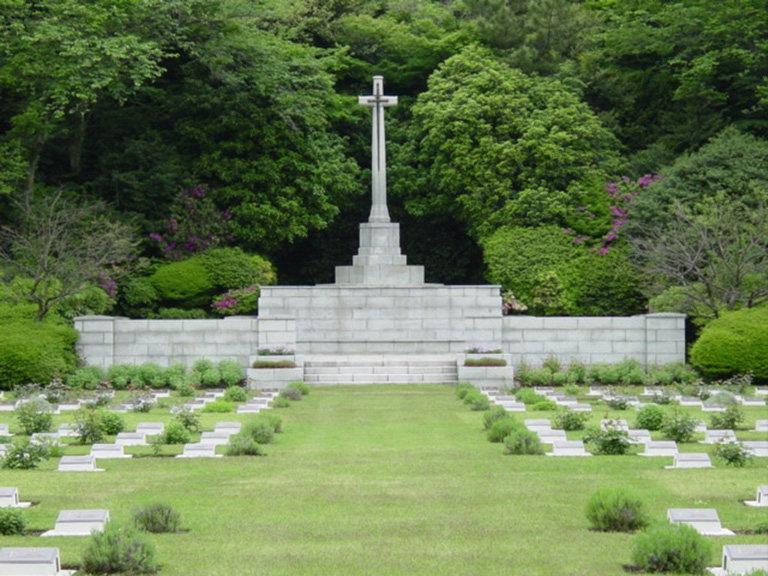Yokohama War Cemetery
- Country Japan
- Total identified casualties 1507 Find these casualties
- Identified casualties from First & Second World War
- GPS Coordinates Latitude: 35.43396, Longitude: 139.58133
Cemetery Spotlight: Yokohama War Cemetery
The Commonwealth War Graves Commission’s Yokohama War Cemetery is a living landscape, lovingly sculpted by a small team of gardeners who blend rigorous horticulture with the mindful principles of kaizen.
Most CWGC cemeteries are instantly recognisable by their generous lawns and regimented avenues of roses, but Yokohama has its own personality. When Australian forces constructed the site after the war, they brought with them the scent of home in the form of eucalyptus saplings.
Over seven decades later, those original trees have continued to grow, lending the Australian and post-war sections a uniquely Antipodean atmosphere.

A team member ensures the beautiful blooms at Yokohama remain nice and healthy.
Equally extraordinary is a lone kauri, a species sacred to New Zealand Māori. Transplanted from the former New Zealand Embassy in Tokyo, the kauri could, in theory, survive for millennium.
In the High season (April – November), the zoysia turf shakes off winter dormancy, and the gardeners focus on the Field of Honour. From Monday to Thursday, there is plenty of work of mowing, edging borders, weeding and shrub pruning. Fridays are for blowing pathways clear, polishing plaques and cleaning facilities so the weekend’s visitors encounter a site in its Sunday best.

The team potting up a cutting of Otafuku Nandina plant.
In the Low season (December – March), with the lawns at rest, attention turns to the woods that cloak 80% of the 20-acre cemetery. Bamboo encroaches quickly on the slopes, so its runners are checked and cut back. Shrubs are shaped, tree roots aerated, and roses pruned to reduce frost damage and conserve the plant's energy for spring.
Fridays remain a catch-up day for maintaining benches, oiling and repainting gates and repairing the inevitable wear of typhoon and rain.
Work continues even in a downpour: tool maintenance, theoretical training and tidying glasshouses keep the team occupied no matter the Japanese weather.
A closed-loop green waste system ensures that nothing organic leaves the grounds. Grass clippings line woodland paths to suppress weeds; small prunings are composted, while larger branches are chipped into mulch or piled into habitat mounds that double as erosion barriers. Even felled bamboo is repurposed as rustic fencing.

Working together, the team at Yokohama ensure its year-round beauty.
Rainwater, channelled through an on-site circulation system, supplies irrigation tanks and wash basins for tools, reducing potable water consumption. The team brew their own organic fertiliser from rice bran, charcoal and mature compost to encourage beneficial soil microorganisms around tree roots.
With only three full-time horticulturists to care for five distinct burial plots, the staff have adopted the Japanese management principle of kaizen, continuous, incremental improvement.

The team's work speaks for itself! A huge thank you goes to everyone who cares for Yokohama War Cemetery.
Instead of working through a routine task list section by section (a process that once took a month per circuit), they split each horticultural discipline into its simplest components and tackle whichever needs doing now across the entire site. If roses everywhere require dead heading, that becomes the day’s sole focus; edging and cultivation can wait.
Modern equipment helps. Battery powered tools cut noise and emissions, while a ride on mower halves the hours once spent walking behind a petrol machine. Summer heat remains their sternest opponent, so tasks are scheduled to dodge the peak midday temperatures, and mulching is extended to conserve soil moisture and protect roots against scorching.
Recovering from the TYPHOON

Yokohama WAR CEMETERY
Location: Yokohama, Japan Language: Japanese Altitude: 73m Rainfall: 1,530mm
Temperature: -2°c - 37°c Biggest challenge: Typhoons
Yokohama, a neighbouring city of Tokyo, like much of the region, suffered from the effects of the deadly Typhoon Hagibis in October 2019.
A few hours after Typhoon Hagibis had passed, our team set to work. The strong winds had ripped up trees and impaled them on the cemetery’s neat lawn. Elsewhere in Japan, the outcome was even worse.As well as the serious loss of life, power and property, the Commonwealth War Graves Commission’s only war cemetery in Japan fell victim too.

Winds up to 160mph ripped apart trees in Yokohama during Typhoon Hagibis.
Thankfully all staff and their families were unharmed. Only hours before it struck, CWGC’s Japan country manager, was in the cemetery, giving a video tour and discussing which trees might be at risk.
The next day his team set to work quickly clearing up the aftermath.
In calmer times this space boasts an abundance of life; flowers and trees that mix native Asian species with more regional varieties that reflect the Commonwealth war dead buried below.
Created after the Second World War, Yokohama contains the remains and war memorials of more than 2,000 war dead.

Yokohama is divided into five sections for the Commonwealth and post-war.

The ashes of 335 men from the Commonwealth, USA and the Netherlands sit inside the Yokohama shrine.
Most were Prisoners of War who died in captivity in gruelling conditions. Their lives and deaths are now preserved in this parkland setting amid the largest urban area on the planet.
Nearby, hundreds of thousands of rugby fans poured through the doors of the Yokohama International Stadium during the Rugby World Cup; many Brits, Australians and New Zealanders among them.
While their thoughts will have been on tries and tackles, our Japanese staff were watering and weeding the Commonwealth graves of those fans’ forebears – men who only a few generations ago would have been enemies.
And among those graves, there is buried a true friend. In the non-war plot lies former Commission gardener, Len Harrop MBE. Ex-soldier and guardian of this cemetery from 1952 to 1986.
From the harrowing work of recovering bodies to cultivating plants, his life spanned the battlefields of Normandy to Yokohama War Cemetery. And just as he did for more than three decades, when the storm winds passed, the latest generation of CWGC staff returned to make sure that everyone buried there could continue to rest in peace.
Over seven decades later, those original trees have continued to grow, lending the Australian and post-war sections a uniquely Antipodean atmosphere.

CWGC staff at work on a quieter day, tending our only Japanese war cemetery.
Location information
Yokohama War Cemetery is 9 kilometres west of the city centre on Jido-Yuenchi-Dori, Hodogaya Ward, which branches about 300 metres left off the old Tokaido highway.
The best way to reach the Cemetery is by taking the number 53 bus (correct as at 24/7/2019), which departs every 20 to 30 minutes from Hodogaya Railway Station, approximately 4 kilometres away. To locate the bus stop, leave the railway station via the ‘East’ exit, in the direction of Tokaido Highway. It is on the opposite side of the Highway and can be accessed via the pedestrian bridge.
When boarding, please let the driver know that you need the bus stop at Nagatadai Kouen Mae (永田台公園前) and will be visiting ‘Yokohama War Cemetery’ (‘英連邦墓地eirenpobochi’). On arrival at Nagatadai Kouen Mae, you should follow the road for approximately 100 metres, in the direction that the bus was travelling. The Cemetery is located on the right-hand side of the road and is marked by two brick pillars and a metal gate. There is also a sign outside the Cemetery, showing the CWGC logo and ‘Commonwealth War Cemetery Yokohama’ written in English. The Cemetery’s address is 238 Karibachō, Hodagaya-Ku, Yokohama 240.
Yokohama Post War Plot is situated in Yokohama War cemetery and is reached by going up through the United Kingdom Section, up the steps to the Indian Section and then following a sloping path.
Visiting information
PARKING
There is a car park outside the main entrance gates, there are spaces for vehicles. The car park is level, the surface of the car park is cobbled.
MAIN ENTRANCE, ACCESS & LAYOUT
The cemetery is oval shaped, situated in a large, wooded parkland area and there are five sections to the cemetery, each section is a separate burial area or memorial for Commonwealth service personnel.
The cemetery also houses the Yokohama Cremation Memorial and the Yokohama Memorial, where twenty members of the undivided India and Indian Royal Air Force personnel are buried.
The Australian section is to the right of the main entrance linked to all the other sections by a pathway. There are steps that go up into the Australian plot, a Cross of Sacrifice stands in the centre at the top end of the section.
Follow the path out of the Australian section, the path winds through the park to the New Zealand and Canadian section. Here, there are two sets of steps into the plot. The Cross of Sacrifice is adjacent to the steps.
From the New Zealand and Canadian section, a sealed pathway winds towards the main entrance. There is a T junction in the pathway; follow the path to the right to find the Indian Section, Post War plot and the British Section.
There are three sets of stone steps leading up to the Indian section, to access the Post War and British sections. This is the only route.
There are wooden benches alongside all routes around the cemetery and in each burial section.
ALTERNATIVE ACCESS
Access to the cemetery is through a wide entrance gate that opens onto a smooth path. The path links with other paths and provides a route around the cemetery.
There are parts of the route where it is not possible to access the separate sections without using steps.
ADDITIONAL INFORMATION
The cemetery is open 0800-1630 seven days a week, including public holidays.
History information
YOKOHAMA WAR CEMETERY was constructed by the Australian War Graves Group after the Second World War and contains the graves of Commonwealth servicemen who died in Japan as prisoners of war or with the occupying forces after the war. It comprises of four main parts; the United Kingdom section, the Australian section, the Canadian and New Zealand section and the Indian Forces 1939-1945 section.
The cemetery contains 1,555 Commonwealth burials and commemorations of the Second World War, including 53 unidentified burials and a small number of special memorials to casualties known to be buried in the cemetery, whose graves could not be precisely located. There is also one First World War burial and a Dutch war grave. The POST WAR PLOT contains 171 non-war service and civilian burials.
The cemetery also contains the YOKOHAMA MEMORIAL which commemorates 20 members of the Army of Undivided India and the Royal Indian Air Force who died while serving with the occupation forces in Japan, for whom no burial or cremation information exists.
The YOKOHAMA CREMATION MEMORIAL, a shrine which houses an urn containing the ashes of 335 soldiers, sailors and airmen of the Commonwealth, the United States of America and the Netherlands who died as prisoners of war in Japan also stands within the cemetery. Their names (save for 51 who were not identified) are inscribed on the walls of the shrine.



